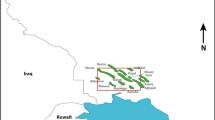Abstract
Findings of the oil source affinity for oil sample collected from shallow borehole already drilled for ground water purposes at the Sakran area, NE Haditha city, western Iraq, is performed in this study by biomarker studies with addition to the analysis of gravity map. Petroleum geochemistry study is carried out on oil sample. The terpane and sterane biomarker distributions, as well as the stable isotope values, are used for determining the validity of oil to correlate its source. The results showed that the oil belongs to the Jurassic age, with high sulfur content (2.75 %) and value of C28/C29 up to 0.75. The tricyclic terpanes values as well as hopanes indicated a source rock affinity of carbonates, whereas the pristine/phytane ratio indicated marine algal source of kerogen type II. All these information could confirm that the source rock affinity was the Sargelu Formation (Jurassic), in which their age’s equivalent to the source in East Baghdad Oil Field and Tikrit Oil Field, with a difference from the oil family near the Akkas field, located to the west of the area. Chemical analyses of water sample collected from the borehole showed the following results: TDS = 12,700 mg/l, EC = 215,900 μs/cm, pH = 6.8, DO = 28 mg/l, and temperature = 24 °C. Hydrochemical functions such as rNa/rCl (<1), (rNa–rCl)/rSO4 (<0) and rSO4/rCl (<1) indicate that the water is of marine origin, partially mixed with meteoric water. Analysis of the gravity map revealed two anomalous areas; the western one represents large anomaly with EW trend similar to the Anah graben to the north. The second one consists of many anomalies trending N–NW direction. The main local anomaly is identical with the seeps from the drilled borehole covering large area. The boundaries and trends of the main geological structures have been defined by gradient analysis procedure to the gravity data. The closed gravity anomalies with their large extensions reflect the importance of the results for further studies and promising area for oil reservoirs.















Similar content being viewed by others
References
Al-Ameri TK (2010) Palynostratigraphy and the assessment of gas and oil generation and accumulations in the Lower Palaeozoic. Western Iraq, Arabian Journal of Geoscience 3:155–179
Al-Ameri TK (2011) Khasib and Tannuma oil sources, East Baghdad oil field, Iraq. J Marine Petrol Geo 28:880–894
Al-Ameri TK, Wicander R (2008) An assement of the gas generation potential of the Ordovcian Khbour Formation, West Iraq. Comunicacoes Geol 95:157–166
Al-Haba YK, Al-Samarrai A, Al-Jubori F, Georgis NN, Mahoud MD, Ahmed IM (1994) Exploration for the Paleozoic Prospects in Western Iraq. Part1: exploration of the Paleozoic system in Western Iraq. Part 2: high temperature influence in exploration for Paleozoic reservoirs in the light of drilling results from well Akkas-1. In Proceedings of the second Seminar on Hydrocarbon Potential of Deep Formations in Arab Countries (OAPEC), Cario 10–13 October (in Arabic)
Al-Hajri S , Owens B (2000) Stratigraphic palynology of the Paleozoic of Saudi Arabia. GeoArabia Spec. Publ. 1. Gulff Petrolink Bahrain. 231p
Al-Sakini JA (1992) Summary of petroleum geology of Iraq and the Middle East. Northern Oil Company Press, Kirkuk (in Arabic)
Al-Sharhan AS, Nairn AE (1997) Sedimentary basins and petroleum geology of the Middle East. Elsevier, Amsterdam
Aqrawi AA (1998) Paleozoic stratigraphy and petroleum systems of the western and southwestern deserts of Iraq, Gulf Petrolink, Bahrain. GeoArabia 3(2):229–248
Aqrawi AA, Goff JC, Horbury A D, Sadooni FN (2010) The Petroleum Geology of Iraq. Scientific Press, Bucks
Bellen RC, Van Dunnington HV,Wetzel R, and Morton DM (1959) Lexique stratigraphquie international, vol III, Asie, Fasicule 10a Iraq. Centre National de la Recherche Scientifique
Dunnington HV (1958) Generation, migration, accumulation and dissipation of oil in Northern Iraq. In: Weeks GL (ed) Habitat of Oil, a Symposium. AAPG, Tusa
Fouad SF, Nasir WA (2009) Tectonic and structural evolution of Al-Jazira area. Iraq Bull. Geol Min Special Issue 3:33–48
Hunt JM (1996) Petroleum geochemistry and geology. W. H. Freeman, New York, p 743
Jassim SZ, Al-Gailani M (2006) Hydrocarbons. In: Jassim SZ, Goff JC (eds) Geology of Iraq. Dolin, Prague and Moravian Museum, Brno, pp 232–250
Paul Philp R (2003) Formation and geochemistry of oil and gas. In: Holland HD, Turekian KK, Mackenzie FT (eds) Treatise on geochemistry. Elsevier, Amsterdam, pp 223–256
Peters KE, Walters CC, Moldowan JM (2005) The biomarker guide. Cambridge University Press, Cambridge.
Pitman Janet K, D Steinshour D, Lewan MD (2004) Petroleum generation and migration in the Mesopotamian Basin and Zagros Fold Belt of Iraq: result from a basin modeling study. GeoArabia Gulf Petrolink, Bahrain 9(4):41–72
Pollastro RM, Karshbaum AS, Viger RG (1999) Map showing geology, oil and gas fields, and geologic provinces of the Arabian Peninsula. US Geological Survey, Open File Report 97-470B, Version 2
Sharland PR, Archer R, Cassey DM, Davies RB, Hall SH, Heward AP, Horbery AD, Simmons MD (2001) Arabian plate sequence stratigraphy. Gulf PetroLink, Bahrain
Verma MK, Ahlbrandt TS, Al-Gailani M (2004) Petroleum reserves and undiscovered resources in the total petroleum systems of Iraq: reserve growth and production implications. GeoArabia 9(3):51–74
Zumberge JE and Summons RS (2004) Crude oils provide molecular and isotopic clues about OAEs. AAPG Meeting with Abstracts, Dallas
Zumberge JE, Russell JA, Reid SA (2005) Charging of Elk Hills reservoirs as determined by oil geochemistry. AAPG Bull 89:1347–1371
Author information
Authors and Affiliations
Corresponding author
Rights and permissions
About this article
Cite this article
Al-Rawi, F.R., Al-Ameri, T.K. & Awadh, S.M. Petroleum geochemistry of oil samples from shallow boreholes at Sakran site, western Iraq. Arab J Geosci 7, 545–558 (2014). https://doi.org/10.1007/s12517-012-0813-1
Received:
Accepted:
Published:
Issue Date:
DOI: https://doi.org/10.1007/s12517-012-0813-1




